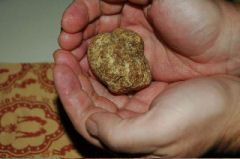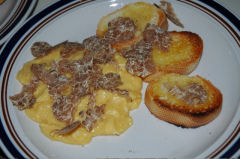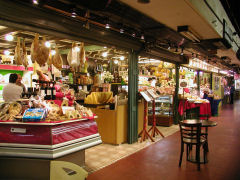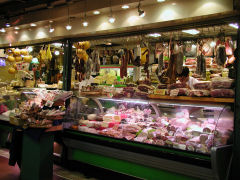Buenos Aires – I saw my friend Nestor, who produces various wine “accessories”, the other night at the housewarming party and we got to talking about food markets. That’s what foodies do at parties. I was wondering if there was some slim chance that someone in Buenos Aires was importing white truffles from Italy. ‘Tis the season, and my friend Tom in New York sent me a couple of food porn shots. Nestor didn’t think it very likely, given the expense, and import taxes, but suggested that if anyone were to have them, or know about them, it would be the Italian market in the food market in Belgrano. Food market in Belgrano? Why has no one told me about this?


So off I went yesterday to the Feria Modelo Belgrano Mercado Belgrano, Juramento 2527, just off the corner of Ciudad de la Paz. It was closed. Well, only for a short while. Turns out it’s open in the mornings until 1 p.m. and then again from 5 p.m. until 8:30 p.m., Monday through Saturday. I had two hours to kill. Luckily, Belgrano is a great shopping neighborhood, including for food.
Casa Polti, Juramento 2499 2455 (and now a second spot in the Mercado Belgrano, above), on the corner of Ciudad de la Paz, is an impressive little spice, herb, and dry goods shop. Shelves lined with jars of various powders and leaves and stems. Sacks on the floor filled with seeds and nuts from all over. A wide array of sauces from around the globe. Just to give you a sense of some of the oddities – tomato powder, fig syrup, squid ink, and cacao husks. A lot of what they have seems oriented around medicinal use, but there’s plenty to choose from. Truffle oil, but no truffles.
Tonel Privado, Ciudad de la Paz 2129, right next door to Casa Polti, is one of a ten-shop group of wine stores. They’re specialty is higher end wines, though they have a decent range at more affordable price levels as well. They’ve also got a decent selection of imported wine from France, Italy, Spain, and Australia. Want a bottle of 1994 Château Margaux? A mere 1,920 pesos (2-3 times the price in New York). Cos d’Estournel 1997? 660 pesos (4-5 times the NY price). Such is life with imported wine here. Interestingly, truffle oil here as well. No truffles.
La Comarca, Juramento 2492, just off the opposite corner. Attached to a small restaurant called Bavaria, that advertises a specialty in the cooking of Eastern Europe (no menu was posted, so I can’t tell you what they have), is this small ice cream shop. And we’ve moved up a step from very good to excellent in the great ice cream hunt here in Buenos Aires. The chocolate amargo was spectacularly good, and they have a nice selection of other flavors, including a couple of specialties that I sampled, my favorite being amore – a blend of dulce de leche ice cream with caramelized almonds and grated dark chocolate. No truffle ice cream, thankfully.
Between those three shops and a bit of wandering around in bookstores and other shops, I managed to make it through my two hour wait. So it was back to the Feria Modelo Belgrano, which was re-opened. I was greeted immediately by this shop, Valenti, which will, I’m sure, become a regular place for me. It’s immediately to the left on entering… [I later found out that this is a chain of gourmet food shops with branches around the city, including one a short walk from home.]


They have a huge array, as you can see, of cheeses and meats, and other “delicatessen” products. Almost everything is imported. You can find cheeses from Italy, Spain, France, and England, and cured meats from all over Europe. This was the place to ask about the elusive white truffles. They didn’t have any, but offered to make some calls for me and find out if there were any available in town, and/or how much it would cost to bring one in (okay, that would be outrageous, and way out of my budget, but it was nice of them to offer). I’m to call them or come back on Monday afternoon to find out the results of their inquiries. I picked up some cheddar cheese, and some of my favorite cured meat – jamón serrano, which if you’ve never had, you simply must.
Jamón Serrano is the hind leg of the white pig, obtained under proper slaughtering and quartering conditions and subjected to a process of salting/drying and curing under perfectly defined conditions. The result is a meat product with exceptional sensory and nutritional qualities.
Jamón Serrano is one of the cornerstones of Spanish gastronomy. It is Spain’s most outstanding meat product, not only because of its high levels of consumption and deep-rooted tradition but also because of its high quality.
The word “serrano” in Spanish refers to the sierra, or mountains. Jamón Serrano is traditionally produced in mountain environments where the air is clean, the moisture levels just right and the winters cold. These are the traditional requirements for curing.
Excerpted from the link above, from Plaza de España Gourmet Food, LLC
The rest of the market is not quite as eye-catching to look at, but there are several excellent fruit and vegetable stands, and then, what I gather the market is famous for, numerous specialty butcher shops. One shop specializes in all things pork, another in lamb, another in poultry (quail, partridge, pheasant, turkey, duck, various breeds and ages of chicken), another in specialty meats (vizcuna, cuy, rabbit, armadillo, and others), another in fish and shellfish. There are roughly a dozen butcher shops, each with their own specialty.
Needless to say, this place is well worth the trip!
I understand that protective tarriffs drive up the cost of imported wines. What I don’t understand is the price for some Argentine wines here in the United States is actually less than in Argentina.
Achaval Ferrer Quimera 2002 ( a delightful corte) in Argentina goes for about 100pesos per bottle. I bought a case here for U$19 per bottle. Go figure.
It really comes down to that some of those wines are specifically produced for the export market and are not “approved” for local distribution. I’ve seen two different things – either they’re specifically priced high here in order to lower local consumption, leaving more for export (happens a lot with the higher end “international style” wines); or, literally, they’re sold as exports to, say, a distributor in Chile or Brazil or Uruguay, and then brought back in as imports! Talk about high taxes!
[…] The Great Ice Cream Hunt continues. I can see this is going to be a process of visits and revisits, it may even require a group tasting one day to compare. I’d already upped the ante from very good to excellent with a visit to La Comarca. We’ve now moved a shade further into the excellent category. Un Altra Volta, Santa Fe 1826, just off the corner of Callao (and three other listed locations, this one is apparently new), has me captivated for the moment. I like its gleaming white and chrome layout, somehow or other they’ve managed to take a look that should appear like a hospital sanitization chamber of some sort and make it seem both futuristic and inviting. […]
[…] We, of course didn’t. Remember the whole seafood thing? We did start with a small tapas plate that arrived as a gift from the kitchen – a delicious mound of boquerones (vinegar cured anchovies) and olives, accompanied by shots of slightly over the hill sherry. From there, of course, in keeping with our theme, we found ourselves surrounded by a selection of jamón serrano, grilled riñoncitos, grilled mollejas, and, oh, yes, a shrimp “cocktail”. The first item, of course, is my favorite ham in the world, and I was happy to see the room literally festooned with curing hams. It had excellent flavor, though was sliced a trifle thick, making it somewhat chewy to eat, though I’d still order it again in a heartbeat. The grilled kidneys and sweetbreads should have been left in whichever animal they came from. They were as dry as dust, without quite as much flavor. Meanwhile, we were surrounded by diners happily eating their way through heaps of garlicky prawns, grilled octopi, and bowls of seafood soups. We did get a touch of seafood in the shrimp cocktail, though it was the strangest (though tasty) blend of baby shrimp, apples, and hearts of palm, all dressed in a housemade salsa golf (mayo and ketchup, more or less). […]
[…] When you exit into the sunlight at Primera Junta, you find yourself along Avenida Rivadavia, one of the principal thoroughfares of the city. You also find yourself across the street from the hulking Mercado del Progreso a nearly block-square food market that dates back nearly 130 years. Inside, you won’t find the fancy spice and cheese shops of Feria Modelo Belgrano, but instead, shop after shop dedicated to fresh produce – much of which you won’t see anywhere else in the city (a huge box of raw olives to brine yourself – a mere 6 pesos per kilo), beef and other red meats, chicken, rabbit, fish, wine (one store with a huge display of various jug wines), and artesanal products like sausages and matambre. In fact, as you wander the corridors, it’s not unusual to come across a work table laid out with a local butcher hand preparing and rolling some of the best matambre you’ll ever taste, or stuffing meters and meters of fresh chorizos. While open to the public Monday through Saturday during the mornings (until 1:00) and then later in the afternoon from 5:00 – 10:00, the market is a private enclave of iconoclastic producers. I wasn’t in the space snapping photos more than two minutes before I was accosted by the market’s security. Luckily, they were delighted with my reasons for being there and taking photos, and a few smiles all around and suddenly stall owners were offering me samples and chatting about their products, and even demanding that I include their photos in my writeup! I’ll leave the rest of this as a photo essay. […]
[…] This may not be the prettiest presentation in the world, but the flavors are fantastic. The trout is filleted and deboned (I’ve learned not to trust local fish markets in that regard – these were sold as “100% deboned”, it took me 20 minutes to pick the bones out of a half dozen fillets – I use a pair of needlenose pliers that I bought years ago specifically just for this purpose). Heat a cast iron pan very hot, put in a splash of olive oil, and when smoking hot, add the trout fillets, skin side down, to the pan. Immediately lay thinly sliced serrano ham over the fillets, while allowing the skin to crisp up a bit. Then stick the whole thing in a hot oven, to let the fat on the ham melt and baste the fish, and the fish cook through. Don’t overcook the fish! It’s easy to do. These won’t take more than 3-4 minutes in the oven to finish cooking. Top with a the romesco sauce, warmed. […]
[…] As it happened, I had a bag of beautiful red lentils that I’d picked up on a recent trip out to Casa Polti, a great source of various spices, herbs, grains, and the like. They’d just been so pretty I couldn’t resist getting some. So when I saw “red lentils” in the title… I thought… well… a shame there’s no acorn squash in the house. But the corner market had some nice ripe butternut squash (here called zapallo coreano, or Korean squash), and that makes a decent substitute. I pretty much followed the recipe as presented, other than the squash substitution and I had yellow bell peppers rather than red. […]
[…] it was all the thing in New York at the time. There wasn’t alot to change, I actually love jamón serrano served up this way and have prepared it many times. I vaguely recall that the idea came from some […]
[…] garlic, and parsley. We also, despite it not being Basque, just had to have a plate of our favorite jamón serrano, thinly sliced and draped on another plate for sharing. We also ordered a bottle of a quite […]
[…] with nothing of great note, though the upper floor of the center is home to the Recoleta branch of Valenti, a gourmet provider of cheeses, cured meats, and similar sorts of things. There’s also a […]
[…] less variety of product, despite far more quantity, than what I can find at Mercado del Progreso or Feria Modelo Belgrano. You will potentially save money, if you have a way to cart stuff back in quantity. For the most […]
Thank you soooo much for the info on the Italian market in Buenos Aires!!! I am a foodie as well and didn’t know where to go for my specialty items as I am throwing a dinner party this evening! Well I am off to the market!!!
[…] open at night and will have to wait until another time. The second, however, is located inside the Ferí de Belgrano, around in the back passageway, it’s called El Mercado de Medio Oriente. It was as sweltering […]